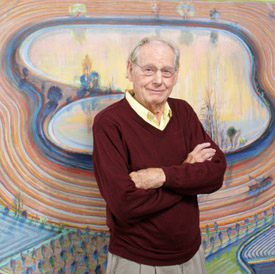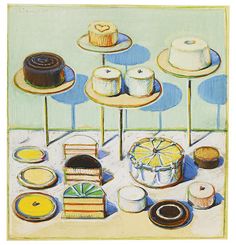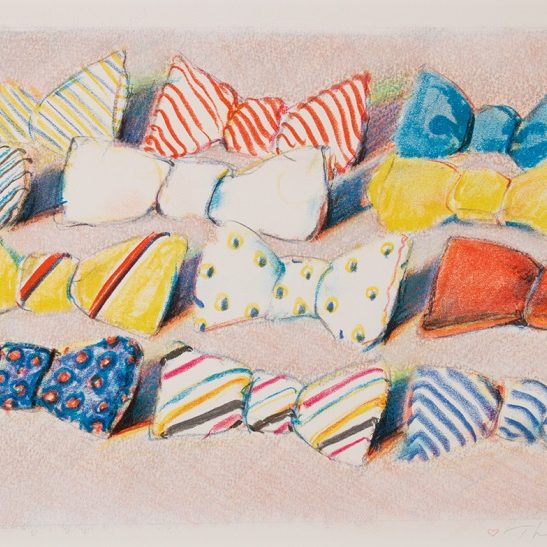I interviewed Wayne Thiebaud on March 16, 2009, at the LaBaron’s Fine Art Gallery, in Sacramento, California. It was a drizzly morning but the gallery’s tall white walls and sky lights created an airy atmosphere. Our 60-minute interview easily flowed into 90-minutes without either one of us noticing. Personally, I could have stayed there all day soaking in every word this brilliant artist had to offer.
RF: When people write about your work they use such words and phrases as: ‘what happiness feels like’; ‘radiant rainbow outlines’; ‘dance of brushstrokes’; and, ‘joyful’. I wonder, is the light and humor in your work a reflection of you as a person or more influenced by something outside your control?
Those pictures are a result of my being a spoiled child.
WT: Those pictures are a result of my being a spoiled child. My parents were terrific parents and I could really do nothing wrong. So, I had one of those privileged spoiled lives.
RF: It’s interesting that you would say that having grown up in the Depression.
WT: Yes, and it was an astounding experience, particularly in reference to what’s happening now. But then we had moved, my dad sort of lost everything, he lost all the money he had except for enough to go in with some members of the family to buy a ranch in southern Utah. So, I was raised during that particular time when I was young, and we always had plenty to eat because we grew crops. The only problem was we couldn’t sell them. So, that was a really wonderful time for me as a child. And my parents were of course hard-working but dedicated to the fact that we would get our way out of it. We were on the farm mainly when the depths of the Depression occurred.
RF: Then you moved to Southern California, right?
WT: Right – to Long Beach – which was a wonderful old place to grow up.
RF: And a continuation of a wonderful childhood. I can just imagine growing up on the beach.
WT: Yes, it was great.
RF: On that same note of how you grew up and what you bring to painting: You were friends with the de Koonings and met them, I think, when you went to New York the first time…
My heroes were people like de Kooning and Arshile Gorky and that whole wonderful period of New York painting.
WT: Right. I stayed in New York two times in my life, about a year each time. The first year I tried to sell cartoons and I wanted to work in advertising. Then, when I got interested in painting, I came back ten years later in 1956. My heroes were people like de Kooning and Arshile Gorky and that whole wonderful period of New York painting. And that was a great changing experience. I had started teaching at the Long Beach Junior College so I had to take a year off without pay and went back and worked again in New York advertising, but spent time in the evenings and weekends getting to meet those people, going to exhibitions, spending time in the Cedar Tavern – it became such a famous place – but at the time it was kind of one relatively small art world. And you saw at openings, and in the general context of that period, critics, artists, writers, poets, all the kind of community. So, that was a great changing experience for me.
RF: I wonder if you had – the first or second time you stayed in NY – if your comics had taken off and you had gotten a job in NY, do you think living in NY would have changed the way you painted or the way your painting had evolved over the years?
He made me shape-up more; made me do more reading; made me understand what real critical interrogation of work was about.
WT: I think…I had already met someone who was a great model, what you would call a really serious person who worked doing painting and sculpture, and he became a very critical kind of influence. He made me shape-up more; made me do more reading; made me understand what real critical interrogation of work was about. His name was Robert Mallary. He was a terrific influence.
RF: Would you tell me some of the things he recommended you do at the time and how he made you ‘shape-up’?
WT: Essentially, work harder; develop a critical sense; understand what you are doing and know how to design problems which would get you to someplace where you thought you wanted to be. And that was very helpful. He would spend hours on what it was to interrogate a work of art: How to understand it in terms of its formal relationship; how to develop alternatives; hypothetical possibilities that you should learn to think about; how to sit and reflect and really try to determine in your mind running alternatives to what you were doing in terms of the picture’s potential. Make it darker, how to transfer it from, say, one kind of value structure to a higher structure, what that would do to it. What to do if you were to take all your color out of it and do it in black and white. Those options, which represent for a painter, I think, the tools of use and how to prepare for yourself always to be specific in order to take risks, to not be afraid of failure, make lots of work which is worth only throwing out. So, that was a very big and helpful exercise.
RF: Not being afraid to fail is a really important thing for an artist, isn’t it?
WT: Very much so. And for students, particularly, getting them used to that, and getting them used to the idea that the ‘nerve of failure’ is a very important aspect of painting, and while it makes you uncomfortable and vulnerable, if you don’t elevate your desires and ambitions to some kind of level of reality in terms of the long tradition that you are a part of however small then you have the risk of ignobling that great tradition which we use and which we respect and which we are hopefully a part of.
RF: I recently read that a high percentage of art students never actually go on to be artists.
WT: Yes, it’s a high fall-out rate.
RF: Why do you think that is?
WT: Well, it’s too damn difficult and too painful on the one hand. I think it’s a kind of neurosis. You have to give up a lot to gain a little. There are no guaranteed results. Those are not good options for a life. But if you are willing to make a life out of it, if you can learn to hope for the best and be prepared for the worst, and see the painting itself as an extraordinary human invention – that becomes enough for you – then going to museums, taking it on, loving what you’re doing, conditioned to the failures, getting some good instruction and critical reaction, which has nothing to do with success but has to do with a realization of where you are, what kind of progress you’re making and ways to do that and to form – I think, also another important thing – a kind of community of your own with some of the people, whether it’s one other person or a group of people. Those groups represent a kind of balancing act where you can have some kind of frank, honest confrontation and some sort of shared, communal love and series of responses; then you’re going to be okay, then you’re going to find a way to do those things which you love to do and are willing to give up those things that have no guaranteed results.
RF: Since we’re on this track, what’s the best advice you give your students? What do you really want them to take away – because you are still teaching at UC Davis, right?
WT: You’d have to ask the students about teaching. (chuckles) Teaching is one of the great other activities of my life. It still intrigues me, it still baffles me. You try to figure out to what extent you can have influence and what kind of influence you are responsible to have. Your responsibility, it seems to me, is to try to give them, first of all, those great examples of what it is to make these paintings, which are miracles, and to respect that and to understand that; to try to develop and show them what tools there are to make that possible.
RF: I’m always curious about this: I think the best instructors are able to help students find their own voice. You don’t see a lot of Wayne Thiebaud wannabes out there. How are you able to do that, encourage your students to find their own voice?
WT: Thank God for that! You have to aim higher than that.
RF: (Laugh) Oh, stop!
You are in a serious business. You are in the world of Rembrandt, Degas, Picasso, Michelangelo. How audacious that is to pick up a brush in light of what’s been done, right?
WT: No, I’m serious; it’s not a false humility. You are in a serious business. You are in the world of Rembrandt, Degas, Picasso, Michelangelo. How audacious that is to pick up a brush in light of what’s been done, right? So, nothing to do with false modesty at all but to try and account for yourself in some way and to try and liken your own development and how you might be making some progress and what traps there are for you out there. To try and avoid becoming what I might refer to as an ‘art world employee’ where you develop these products of commercial value, where you manufacture some kind of product. That’s not what painting is about. Painting is about, for me, research, confrontation, taking risks, going on and trying to challenge yourself to get better always. So, it’s a – I don’t know where we started with this question – it has to do really with some kind of self-confrontation, continuously. And there are lots of issues that are wonderful alternative also to the kind of dedication it takes to do what might be a parallel instance of art and science, where there is research (science), which may be totally irrelevant to what you are doing or may be on the cusp of some discovery, or applied research which has very good formidable functions and uses, and that’s something which I admire a lot, like great graphic designers, illustrators. In those realms, those also have the capacity to make art – whatever art is. And that’s an important distinction for me to be sure that you are careful about calling yourself an artist and be proud of calling yourself a designer, craftsman, painter, so that you are on a realistic footing.
Art is something which we are still trying to define. It’s an abstraction. I’m talking about it like I know what I’m talking about. All I’m doing is telling you my prejudices.
RF: I appreciate that. It’s a question I ask artists all the time: When does it become art? So many artists, you start out copying and growing, illustration is a great foundation, but when does it go from illustration to fine art? Those lines are kind of blurry, I think.
WT: Very, very blurry. It has to do, I suppose, in a simple minded sense from the extraordinariness, and it has to be something really special, something golden, something so extreme, so accomplished that you can say, “That probably is art.” But that is very rare. Most of us will never be artists. Most of what we do won’t be art; it will be some stumbling, half-way, partial, interesting, effective – and those are all very sound reasons to do. It would be wildly impossible to be artists. God bless those people who do it. Berthe Morisot is an artist. Rosa Bonheur is an artist, for me, beyond, and because, they are also painters and they use painting as the medium which allows them to get through to an extraordinary accomplishment. Yes, I call that art.


